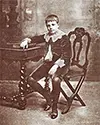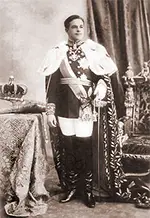King Manuel II of Portugal
Manuel II was the last King of Portugal. He reigned for two-and-one-half years and was then ousted by a revolution that resulted in a republic. 
He was born on Nov. 15, 1889, at Belém Palace in Lisbon. His father was the reigning monarch, King Carlos I, and his mother was Amélie of Orléans. Manuel was his parents' secondborn son; their first son, Luí, was the heir apparent. Like his father and older brother, Manuel was an intelligent child and a good student. Fluent in several languages, he also excelled in history and mathematics. A lover of the arts, he was a talented piano player and enjoyed listening to others play music. He also trained in outdoor pursuits, among them fencing, horse riding, and rowing. As was the custom for a king's second son, he entered the Naval Academy. Everything changed on Feb. 1, 1908. Manuel had been with his family at the royal residence of the Palace of Vila Viçosa, in the city of the same name nearly 100 miles east of Lisbon. He had returned early in order to continue his studies and had ridden out to meet his family when they returned on that day. He joined them and, in an open carriage, rode back to the Palace of Necessidades. It was as they were in what is now Commerce Square (but was then the Terriero do Paço) that two assassins fired on the royal family. Both of them fired shots at the king; the bullet that hit him in the neck killed him right away. In response, Luís had drawn his revolver and fired back. He had stood in order to return fire and so was an easier target for the assassins, who shot him a handful of times as well. Manuel was injured in the crossfire; Amélie was unharmed. Police arriving on the scene killed the assassins. The royal carriage rushed Luís to a nearby hospital, where he died. Several days later, Manuel took the throne. 
One of the new king's first acts was to remove from office the prime minister, João Franco, whom Manuel blamed for the assassinations. Franco it was who recommended that King Carlos dissolve the Cortes not long before. Manuel, then just 19, benefited from his people's sympathy in the aftermath of the deaths of his father and older brother. He traveled around the country, meeting with people and receiving much support. He also traveled in other countries, attending the state funeral of England's King Edward VII, who had visited Portugal in 1903. Manuel had embraced the constitution and restored the Cortes, which grew ever more republican. He appointed as prime minister the well liked admiral Francisco Joaqium Ferreira do Amarl. The mood in the country had shifted as well. Even though they personally liked their king, a great many people wanted a fully representative government. On Oct. 4, 1910, armed forces attacked the Palace of Necessidades. Lacking support, the king went to the Mafra National Palace; his mother and grandmother joined him there. the next day, the royal family sailed for Porto. They never arrived. After hearing that that city had fallen to republican forces as well, Manual ordered the royal yacht to sail to Gibraltar. Manuel never returned to Portugal, instead sailing to the U.K. He married Princess Augusta Viktoria of Hohenzollern-Sigmaringen on Sept. 4, 1913, in Sigmaringen Castle. They lived in London and had no children. During World War I served in the British Red Cross, setting up medical centers and fund drives and visiting troops on the front lines. Manuel maintained a close relationship with the new U.K. king, George V and continued to speak out for a return of the monarchy. Manuel did not want a counter-revolution, however; he wanted the people to choose a return to constitutional monarchy. They did not. In his later years, Manuel II embraced book collecting and published a three-volume set of early Portuguese books. He died on July 2, 1932, at Fulwell Lodge, his residence in the U.K. He had expressed his wish to be buried on Portuguese soil; his wish was granted. |
|
Social Studies for Kids
copyright 2002–2024
David White




